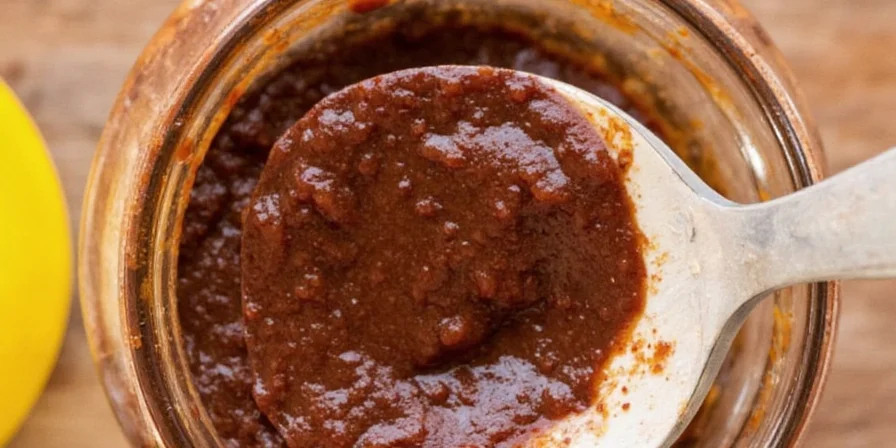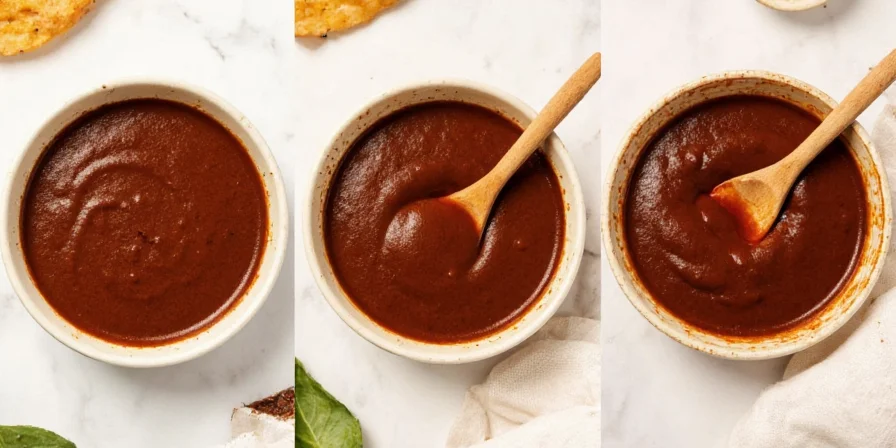Mole sauce is a traditional Mexican sauce made from a complex blend of chilies, spices, nuts, seeds, and sometimes chocolate—but not all varieties contain chocolate. Contrary to popular belief, only mole negro and mole poblano include chocolate, while varieties like mole verde and amarillo rely solely on herbs and spices. Authentic mole balances spicy, sweet, earthy, nutty, and bitter notes, creating a uniquely layered flavor profile that's central to Mexican culinary tradition.
What Exactly Is Mole Sauce? (And Does It Contain Chocolate?)
Mole (pronounced MOH-lay) is Mexico's culinary treasure—a complex sauce originating from regional traditions across Oaxaca and Puebla. Despite common misconceptions, not all mole contains chocolate. Only mole negro (Oaxaca) and mole poblano (Puebla) traditionally include minimal amounts of Mexican chocolate. Varieties like mole verde, amarillo, and chichilo rely exclusively on herbs, seeds, and spices for their complexity. Authentic mole combines dried chilies, nuts, seeds, spices, and sometimes fruit—it's never merely a condiment but a layered cultural expression requiring meticulous preparation.

The Taste Profile: What Does Mole Sauce Actually Taste Like?
Mole's magic lies in its harmonious contradictions. Unlike single-note sauces, it balances five distinct elements:
- Spicy – From dried chilies like ancho, pasilla, or mulato (typically mild to medium heat)
- Sweet – Natural sugars from dried fruits or minimal dark chocolate
- Earthy – Toasted cumin and sesame seeds
- Nutty – Almonds or pumpkin seeds for depth
- Bitter – Charred tortillas or coffee for equilibrium
Contrary to popular belief, authentic mole isn't overwhelmingly spicy—it's a nuanced balance where no single element dominates. The misconception that "mole means chocolate sauce" comes from the popularity of mole poblano in international restaurants.

Spice Basics Behind Mole: What Makes It Unique
Mastering mole requires understanding how spices interact dynamically. Traditional preparations avoid pre-ground mixes, instead toasting whole spices to activate essential oils. Here's what gives mole its distinctive character:
| Spice | Flavor Contribution | Traditional Application |
|---|---|---|
| Cinnamon | Warmth without sweetness | Added late to prevent bitterness in mole negro |
| Anise | Subtle licorice undertones | Used sparingly in Oaxacan recipes |
| Black Pepper | Background heat complexity | Whole peppercorns toasted with chilies |
| Oregano | Earthy herbaceous notes | Mexican oregano only in verde variants |
| Cumin | Nutty foundation | Essential for amarillo's golden hue |

7 Secrets to Authentic Mole Flavor (Most Home Cooks Miss)
Elevate your mole with these often-overlooked techniques from regional kitchens:
- Toasting Precision: Heat chilies until fragrant but not burnt—30 seconds per side max.
- Controlled Char: Blacken tortillas over open flame for smokiness without ashiness.
- Chocolate Selection: Use Mexican tablet chocolate (not baking cocoa) for authentic texture—only in negro and poblano varieties.
- Broth Integration: Simmer sauce with broth for 2 hours minimum to meld flavors.
- Salt Timing: Add salt only after chocolate to prevent seizing.
- Resting Necessity: Refrigerate overnight; flavors deepen significantly after 48 hours.
- Acid Adjustment: Use tamarind paste instead of vinegar for authentic brightness.

Mole Varieties Demystified: Which Contains Chocolate?
Mexico's regional diversity creates distinct mole identities. Note that chocolate appears in only 3 of 7 major varieties:
| Type | Origin Region | Chocolate Content | Key Characteristics |
|---|---|---|---|
| Mole Negro | Oaxaca | Yes (minimal) | 30+ ingredients including plantains; deep smoky notes from charred tortillas |
| Mole Poblano | Puebla | Yes | Sweeter profile with raisins; national dish of Mexico |
| Mole Verde | Central Mexico | No | Fresh herbs pounded in molcajete; vibrant green color |
| Mole Amarillo | Oaxaca | No | Annatto seeds for golden color; cumin-forward |
| Mole Chichilo | Oaxaca | No | Beef marrow for richness; black color from chilhuacle negro |

Perfect Pairings: What Goes Well With Mole?
Authentic pairings respect mole's complexity. Avoid overwhelming it with competing flavors:
- Plain Proteins: Shredded chicken or turkey absorb sauce without distraction
- Neutral Sides: White rice and black beans create a balanced canvas
- Textural Contrast: Crispy plantains cut through richness
- Traditional Vessels: Handmade clay dishes retain heat optimally
- Simple Garnishes: Fresh sesame seeds only—never cilantro

Pro Tips for Home Cooks: Avoiding Common Mistakes
Transform your technique with these often-missed details:
- Does mole need chocolate? Only for negro and poblano varieties—never add chocolate to verde or amarillo
- Batch Blending: Cool ingredients before blending to prevent oil separation
- Straining Necessity: Use a fine mesh strainer—never skip for silky texture
- Heat Management: Simmer on lowest setting; boiling destroys delicate notes
- Freezing Method: Portion in ice cube trays with 1-inch headspace for expansion

Top 5 Mole Sauce Questions Answered
Does mole sauce always contain chocolate?
No. Only mole negro and mole poblano traditionally include chocolate. Varieties like mole verde and mole amarillo rely on herbs, seeds, and spices for complexity without any chocolate. The misconception that all mole contains chocolate comes from the international popularity of mole poblano.
How spicy is mole sauce?
Authentic mole is not primarily spicy—it's a complex balance of flavors. Most traditional varieties range from mild to medium heat (2,000-5,000 SHU), with the heat balanced by sweet, earthy, and nutty elements. The spiciness comes from dried chilies like ancho (mild) or mulato (medium), never from fresh hot peppers.
Why is my mole sauce bitter?
Bitterness usually comes from over-toasted ingredients or burnt tortillas. To fix, add 1 teaspoon of tamarind paste per cup of sauce. Prevent by toasting chilies just until fragrant (30 seconds max per side). Authentic mole should have subtle bitter notes for balance, but not overwhelming bitterness.
What's the difference between mole negro and mole poblano?
Mole negro (Oaxaca) uses 30+ ingredients including plantains and peanuts with deep smoky notes from charred tortillas. Mole poblano (Puebla) is sweeter with raisins and fewer ingredients (15-20). Both contain chocolate, but negro is darker, more complex, and less sweet than poblano, which is Mexico's national dish.
Can I make authentic mole without specialty ingredients?
For true authenticity, specialty ingredients are essential. However, you can make acceptable substitutions: use ancho chilies if mulato are unavailable, but avoid replacing Mexican chocolate with cocoa powder. For mole verde, fresh tomatillos and pumpkin seeds are irreplaceable. Authentic mole requires specific regional ingredients for balanced flavor—this isn't a sauce that adapts well to major substitutions.
Conclusion: Understanding Mole Beyond the Myths
Mole sauce represents culinary alchemy where patience transforms humble ingredients into profound flavor symphonies. This isn't merely about heat—it's balancing ancient techniques with cultural understanding. The most persistent myth—that all mole contains chocolate—is just one misconception that obscures mole's true diversity. For home cooks, starting with mole amarillo provides approachable complexity without chocolate confusion, while mole poblano offers the classic experience many expect. Remember: authentic mole isn't simplified—it's a celebration of complexity that reflects the rich tapestry of Mexican culinary tradition.












 浙公网安备
33010002000092号
浙公网安备
33010002000092号 浙B2-20120091-4
浙B2-20120091-4